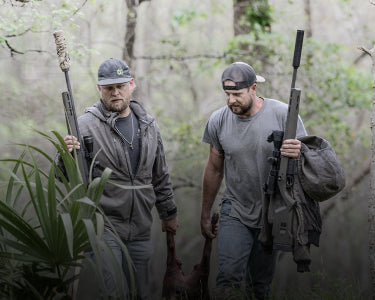Ask ten hunters what “thermal vision” means and at least a few will say, “It’s like night vision, right?” Not quite. Night vision depends on amplifying visible light—moonlight, starlight, even the faint glow from a nearby building. Thermal vision doesn’t care about light at all. It reads heat, detecting infrared energy that every living thing, rock, truck, and engine gives off.
That difference changes everything. You’re not brightening the dark; you’re cutting through it. With a thermal riflescope like the Wraith Mini Thermal, you can spot a hog’s heat signature glowing through brush, a coyote ghosting across a foggy field, or a raccoon clinging to a tree trunk that looks pitch-black to the naked eye.
Because it doesn’t rely on visible light, thermal vision works in conditions that shut down other optics—total darkness, haze, smoke, even daylight glare. It’s not about seeing better in the dark. It’s about seeing what light can’t show you at all.
How Thermal Vision Actually Works
Inside the Wraith Mini Thermal is a microbolometer sensor, a piece of tech built to detect differences in temperature. Every object emits a tiny amount of infrared radiation. The hotter it is, the more energy it gives off. The sensor reads those differences and translates them into an image you can see.
The screen doesn’t show light and shadow—it shows contrast in heat. A running deer glows white against a cool meadow if you’re in “white hot” mode, or dark against a bright background if you prefer “black hot.” Different color palettes let you decide how to interpret the heat picture, whether for quick detection or long viewing sessions.
What’s striking is how steady the picture remains when ordinary optics start to fail. No glare from headlights. No blown-out backgrounds from a full moon. Just a clean, crisp heat map of the world, updated frame by frame in real time.
What Thermal Vision Isn’t
Thermal vision is not night vision, and the difference matters. Night vision needs light to work. That’s why many so-called “digital night vision” scopes still rely on infrared illuminators to project invisible light onto the landscape. The Wraith Mini Thermal doesn’t project anything—it’s passive, picking up what’s already there.
Thermal vision also isn’t magic. You might spot a heat blob at 1,400 yards, but you won’t necessarily know whether it’s a hog, a cow, or a patch of warm dirt until you close the distance. The technology detects heat contrast, not shape or texture. That’s why smart users treat thermal as a detection tool first and an identification aid second.
In the Field with the Wraith Mini Thermal
The Wraith Mini Thermal riflescope is built for hunters who want real results, not gimmicks. Its 384x288 sensor gives enough resolution to spot game through brush or grass without weighing you down. At barely over a pound, it mounts easily to any standard rail and balances well on a hunting rifle.
Imagine you’re glassing from a tree line before dawn. Through a traditional optic, you’d see a whole lot of nothing. Through the Wraith Mini Thermal, you’d spot a line of heat moving low through the field—the telltale gait of a sounder of hogs. You can track them, reposition, and take a shot before they ever realize you’re there.
Because thermal vision detects energy, not light, it works just as well after sunrise. You might use it mid-day to scan tree lines for animals bedding down or check for lingering heat from a shot to confirm a hit. It’s not bound by time of day, and that flexibility makes it one of the most useful tools for wildlife control, security patrols, and serious hunters alike.
Practical Tips for Better Thermal Use
Thermal optics perform best when you learn how heat behaves. Warm rocks, sunlit trees, or recently driven vehicles all hold residual heat. After sunset, those objects cool at different rates, and that shifting contrast can either help or hinder your detection. If the entire field is warm, wait for the temperature to drop—your targets will stand out more sharply.
Battery life is another practical concern. The Wraith Mini Thermal runs for several hours, but if you plan to record hunts or scan continuously, pack a spare power bank. Thermal sensors also stabilize after a short warm-up, so let your unit sit powered on for a minute or two before zeroing or recording.
And remember: thermal doesn’t replace fieldcraft. It enhances it. You still need to move quietly, manage scent, and understand animal behavior. The scope shows you where heat is—it’s your job to turn that into an opportunity.
The Real Advantage of Thermal Vision
Thermal vision gives hunters and landowners a tool that doesn’t quit when the sun goes down. It’s not about flashy tech or marketing buzzwords—it’s about clarity, safety, and control. With the Wraith Mini Thermal on your rifle, you can detect life through the dark, confirm what you’re seeing, and make informed shots in conditions that would stop ordinary optics cold.
It’s heat-based sight. Simple, practical, and quietly brilliant—just the way we like it.
Frequently Asked Questions
What’s the difference between thermal vision and night vision?
Night vision amplifies existing light sources such as moonlight, starlight, and IR illumination, so it needs some form of light to work and can be affected by glare, bright backgrounds, and headlight washout. Thermal vision reads heat instead of light, detecting infrared energy from animals, people, vehicles, and terrain, which lets you see through darkness, haze, smoke, and other conditions that shut down traditional optics.
How does the Sightmark Wraith Mini Thermal work?
The Wraith Mini Thermal uses a microbolometer sensor to detect tiny differences in temperature between objects in the scene. That temperature data is converted into a visual image that shows contrast in heat rather than light and shadow. Different color palettes, such as white hot and black hot, let you choose how that heat picture is displayed for faster detection or more comfortable long-term viewing.
Can I use the Wraith Mini Thermal during the day?
Yes. Because it detects infrared energy instead of relying on visible light, the Wraith Mini Thermal works in full daylight as well as total darkness. You can use it after sunrise to scan tree lines for bedded game, check for lingering heat at an impact point, or monitor fields in bright conditions where traditional night vision would be useless.
What are the limitations of thermal vision for identification?
Thermal vision excels at detection but has limits when it comes to fine identification. You may see a clear heat signature at long distances, but the scope is reading heat contrast, not detailed shape or texture. A hot spot at 1,400 yards might be a hog, a cow, or a warm patch of ground, so responsible users treat thermal as a detection tool first and confirm identity as they close the distance.
How can I get better results and manage battery life with my thermal scope?
Learn how heat behaves in your environment and pay attention to how rocks, trees, and vehicles hold and release warmth after sunset, since changing background temperatures affect how targets stand out. For power, plan around several hours of runtime, carry a spare power bank if you will be recording or scanning constantly, and allow the scope to warm up for a minute or two so the sensor can stabilize before you zero or start a hunt.




